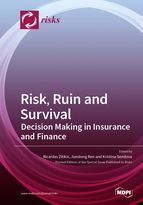Risk, Ruin and Survival: Decision Making in Insurance and Finance
A special issue of Risks (ISSN 2227-9091).
Deadline for manuscript submissions: closed (28 February 2019) | Viewed by 37048
Special Issue Editors
Interests: risk analysis and management; risk measures; econometrics
Interests: ruin theory; risk management; non-life insurance; risk measures
Special Issue Information
Dear Colleagues,
Techniques of measuring risk and calculating probabilities of ruin or survival have been exciting topics for mathematically-inclined academics. For practicing actuaries and financial engineers, these topics have brought opportunities, but also headaches. With this Special Issue, we cordially invite researchers to share their results that, in one way or another, contribute to the betterment of practice and/or theory of decision making under uncertainty.
Dr. Ricardas Zitikis
Dr. Jiandong Ren
Dr. Kristina Sendova
Guest Editor
Manuscript Submission Information
Manuscripts should be submitted online at www.mdpi.com by registering and logging in to this website. Once you are registered, click here to go to the submission form. Manuscripts can be submitted until the deadline. All submissions that pass pre-check are peer-reviewed. Accepted papers will be published continuously in the journal (as soon as accepted) and will be listed together on the special issue website. Research articles, review articles as well as short communications are invited. For planned papers, a title and short abstract (about 100 words) can be sent to the Editorial Office for announcement on this website.
Submitted manuscripts should not have been published previously, nor be under consideration for publication elsewhere (except conference proceedings papers). All manuscripts are thoroughly refereed through a single-blind peer-review process. A guide for authors and other relevant information for submission of manuscripts is available on the Instructions for Authors page. Risks is an international peer-reviewed open access monthly journal published by MDPI.
Please visit the Instructions for Authors page before submitting a manuscript. The Article Processing Charge (APC) for publication in this open access journal is 1800 CHF (Swiss Francs). Submitted papers should be well formatted and use good English. Authors may use MDPI's English editing service prior to publication or during author revisions.
Keywords
- risk measures
- ruin theory
- survival analysis
- financial engineering and management
- decision making under uncertainty
- portfolio construction
- dependence modeling
- statistical methods and inference








